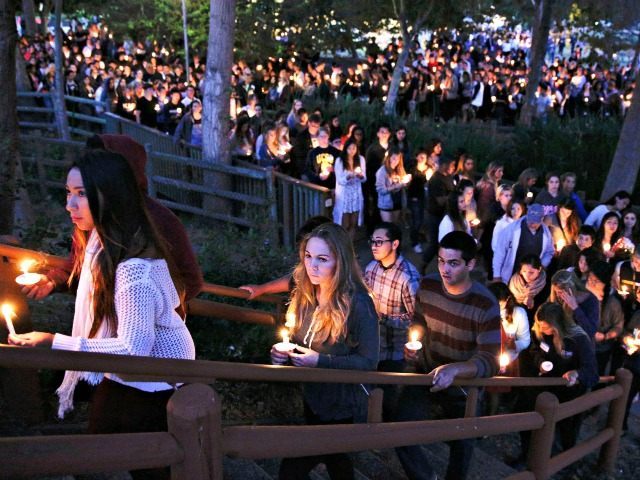“We don’t short sell the presence of evil in this world,” Pastor David Guzik said in his Sunday message following the May 2014 murderous rampage of a disturbed Elliot Rodger, in which he ripped through the community of Isla Vista, California, killing six and wounding several others.
It’s been a year since those egregious attacks stunned the college community nextdoor to University of California Santa Barbara, a marker that is bringing some minds to reflect on the events and whether the area has experienced lasting change. Former UCSB faculty member and alumna Ellen O’Connell documented several community members’ perspectives and reflections in a piece for Salon.
O’Connell remembers going to the candlelight vigil walk the night after the murders. She recalled feeling a call to move on too early in the wake of the six deaths.
This reporter covered the mass murder that weekend, arriving later that same night. The UCSB campus and Isla Vista area were quiet following the vigil, almost eerily so. According to area residents, it was apparently a stark change from the normal Saturday evening that would have otherwise seen scores of partiers.
The days that followed the murders were filled with makeshift memorials where victims had died, flowers, candles, signs, and items that reflected the lives that were lost. There were streams of friends, family, acquaintances, community members and compassionate outsiders paying their respects, and a memorial wall. Then there were the signs making political statements and a barrage of news outlet vans. Candlelight vigils were held at other campuses and locations, also in remembrance.
Now a year later, O’Connell notes the words of sophomore Mel Weisberger of the days just after the murders: “People were being much nicer to each other, the streets were quieter, and there was an overall feeling that everyone just wanted peace.” Many headed home for the summer and returned in the fall. Weisberger tells O’Connell she then “Realized that for a lot of people, it became fashionable to care.”
Sophomore Korrin Alpers told O’Connell, “The tragedy is that we lack ownership—we blame people from out of town, the people who throw wild parties, Greek life, mental illnesses, white privilege, misogyny.”
O’Connell described the reaction from campus administrators directly following the murders as “typical.” She continued, “The national conversations quickly turned political as advocates for gun control, and those opposed to misogyny and rape culture, used the event to make their points. The university hosted a memorial service-turned-rally.”
At the memorial, UC President Janet Napolitano said, “We are here because in this moment of loss there’s a human desire to come together to reach out to one another for love and support,” reported the L.A. Times. An estimated 20,000 attended.
In June 2014, Napolitano announced an anti-sexual violence task force, which O’Connell notes has planned better streetlights and increased police presence. While potentially helpful for students concerned with safety, it would not likely have prevented this occurrence.
Gun laws proposed in the wake of such attacks have been proven faulty. as argued by Breitbart News journalist AWR Hawkins. “For example, Santa Barbara gunman Elliot Rodger had approximately 40 ten-round magazines to compensate for the ban on “high capacity” magazines when he committed his heinous act,” wrote Hawkins. In other similar cases, perpetrators have stolen guns to carry out the debased plans they had grown bent on carrying out.
O’Connell noted that California passed a gun law in October “allowing families and friends of disturbed people to seek a restraining order to ensure they don’t buy a gun.” However, she goes on to say that despite the task forces, gun laws and other preventative efforts, “some students, faculty, and staff do not see visible evidence that Isla Vista is any safer, and claim that the administration’s rhetoric sounds hollow.”
Weisberger told O’Connell, “…they label Rodger as ‘crazy’ and ‘an extremist,’ which he was; but what people don’t talk about is the fact that on a less extreme level, that mentality still exists in some people in Isla Vista.”
Pastor David Guzik, referencing the murders, told the congregation at Calvary Chapel Santa Barbara just two days after they occurred, “It tells us something about our culture and how the idols of our culture work destruction in the lives of troubled people.”
In remembrance, the victims of the May 2014 Isla Vista mass murder: Katherine Breann Cooper (22), Veronika Weiss (19), Christopher Ross Michaels-Martinez (20), George Chen (19), Cheng Yuan Hong (20), and Weihan Wang (20), detailed in a Los Angeles Times report.
The university is holding a Candlelight Vigil and Memorial Walk Saturday evening beginning at 7:30 p.m. at People’s Park in Isla Vista. George Chen’s mother is scheduled to speak. On May 31, the University will hold a “Music in Memory: Isla Vista 2014” event. The Times notes there are several events being held this month to mark the anniversary of the murders.
Just two weeks before the anniversary of this event, an assault and shooting in Isla Vista left four in the hospital. NBC LA reported that two individuals are being accused of involvement and connection to a criminal street gang.
Follow Michelle Moons on Twitter @MichelleDiana

COMMENTS
Please let us know if you're having issues with commenting.